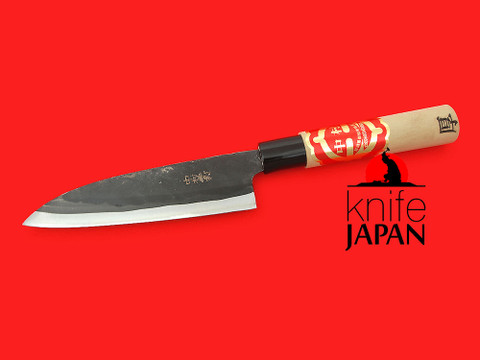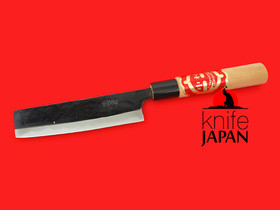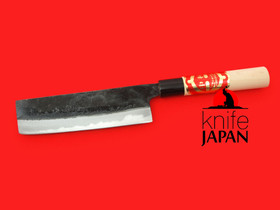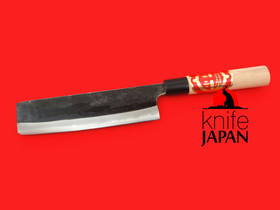Product Description
Ko-bocho means small knife. It's a knife style with a multitude of applications, from fish to meat to vegetables leafy and root, sometimes favouring one over the others (although the thicker ones tend to be called sabaki-bocho). The key is that blade length is fairly modest, as is the case with this particular Miyazaki knife from Nakamura Hamono in the town of Miyakonojo in Miyazaki Prefecture.
Modest length, modest investment, great sharpness and ease of use. Forty-plus years of forging experience distilled into a good all-round purpose kitchen knife with traditional black-forged appeal. You can't really go wrong.
| Blade steel: | Aogami #1 | Nantetsu |
| Bevel: | Ryōba double bevel |
| Blade construction: | Warikomi |
| Left-handed available: | Handle and blade suit both hands |
| Handle: | Hounoki (Magnolia) |
| Ferrule: | Plastic |
| Blade length: | 155mm |
| Overall Length: | 295mm |
| Blade height: | 40mm |
| Blade spine: | 3mm |
| Handle length: | 134mm |
| Handle width: | 27x24mm |
| Weight in hand: | 96g |
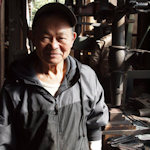
Product Reviews
-
First Japanese knife. Good, but could be better
Posted by J M on 1st Nov 2024
I read some good reviews on Knifejapan and the store itself did not disappoint - the knife got to the UK from Japan within 3 days which was very impressive.
The knife itself.
As it's my first handmade Japanese knife, I waited for it with excitement. Packaging was perfectly adequate - simple, but safe and well padded. Straight after removing the knife from the packaging I've noted about a centimeter of leftover burr at the tip. I managed to get it off quite easily with a ceramic hone. Not a big deal at all, but feels like slight lack of quality control.
Is the knife sharp ? Yes. It cut all the food I tried without any issue, it also cuts paper quite effortlessly.
Is the knife VERY sharp? I wouldn't say so. It definitely isn't sharp enough to shave hair or cut a paper towel. But then again - that's not the purpose of a kitchen knife. Although a £5 victorinox paring knife does that out of the box.
Overall - I'm pleased with it and even more pleased with Knifejapan as a shop (communication and good choice of delivery company), however I think the knifemaker wasn't having his best day when this knife was made :)
Hence 3/5.
Thank you

-
Another great knife that splits hairs
Posted by Unknown on 11th Apr 2021
The blue 1 steel takes a great edge. . . it doesn't immediately cut through hair like some others but instead kinda turns it into a fine shaving. Both behaviors make for really sharp knives. . . .though the only one that shaved hair that way was a tamahagane honyaki knife I got to try once. What that means, I'm not sure. It also bites into my fingernails really aggressively, with great control, so that's new to me, too.
The heel was unsharpened, unlike in the pictures, which is good for scraping the peel of things like gobo, or using that part like a deba. I sharpened it up after a bit, so that was fine. The handle is a tad long, which makes the knife feel a bit like a slicer or mini gyuto if I hold the entire handle. But the knife itself is a tall petty. I might shorten the handle a bit for nimbleness, though the extra length helps with leverage, so its a trade-off. I do get more control when I hold more of the handle, so that might have been the intention. My handle didn't have the cracked wood at the ferrule from hammering in, like in the picture, which was good. There was a slight buIge ferrule end from hammering in, though, not as severe as the pictures -- instead quite slight. This is kind of helpful though, it acts like a mini-sort of a guard to prevent fingers from slipping forward, so I'll spend more time thinking about it. The knife did have a mini-kiritsuke tip at the last couple mm, which sometimes happens to fix chipped tips. Chipped tips are quite easy to accidentally do to a knife, and relatively easy to fix.
The wide neck makes the knife feel more rigid and secure, and the perpendicular filing marks on the spine help with grip. The choil corners are eased with filing marks. The grind is slightly concave with a distinct shoulder on the left side. The blade flats are actually quite flat. . . very slightly concave like most are, with some deeper wide hammer marks near the tip on the left side.
The steel sharpened up with a kind of chrome-ish polish, and comes to quite a fine edge. . . I'm surprised how much the blue 1 steels act like how I thought white 2 would have acted like. There was the tiniest recurve near the heel that I took out during sharpening as well. I plan on using this as a tall petty to replace an old Tosa one of the same length. The old one had a more narrow neck, so it's a trade-off, but both are fine to use.
 Loading... Please wait...
Loading... Please wait...











